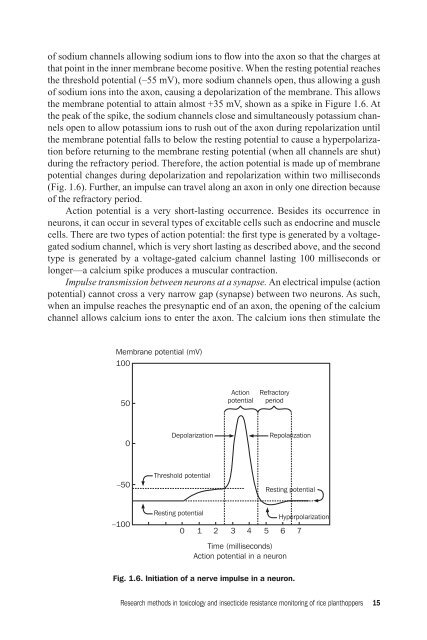Research Methods in Toxicology and Insecticide Resistance ...
Research Methods in Toxicology and Insecticide Resistance ...
Research Methods in Toxicology and Insecticide Resistance ...
Create successful ePaper yourself
Turn your PDF publications into a flip-book with our unique Google optimized e-Paper software.
of sodium channels allow<strong>in</strong>g sodium ions to fl ow <strong>in</strong>to the axon so that the charges at<br />
that po<strong>in</strong>t <strong>in</strong> the <strong>in</strong>ner membrane become positive. When the rest<strong>in</strong>g potential reaches<br />
the threshold potential (–55 mV), more sodium channels open, thus allow<strong>in</strong>g a gush<br />
of sodium ions <strong>in</strong>to the axon, caus<strong>in</strong>g a depolarization of the membrane. This allows<br />
the membrane potential to atta<strong>in</strong> almost +35 mV, shown as a spike <strong>in</strong> Figure 1.6. At<br />
the peak of the spike, the sodium channels close <strong>and</strong> simultaneously potassium channels<br />
open to allow potassium ions to rush out of the axon dur<strong>in</strong>g repolarization until<br />
the membrane potential falls to below the rest<strong>in</strong>g potential to cause a hyperpolarization<br />
before return<strong>in</strong>g to the membrane rest<strong>in</strong>g potential (when all channels are shut)<br />
dur<strong>in</strong>g the refractory period. Therefore, the action potential is made up of membrane<br />
potential changes dur<strong>in</strong>g depolarization <strong>and</strong> repolarization with<strong>in</strong> two milliseconds<br />
(Fig. 1.6). Further, an impulse can travel along an axon <strong>in</strong> only one direction because<br />
of the refractory period.<br />
Action potential is a very short-last<strong>in</strong>g occurrence. Besides its occurrence <strong>in</strong><br />
neurons, it can occur <strong>in</strong> several types of excitable cells such as endocr<strong>in</strong>e <strong>and</strong> muscle<br />
cells. There are two types of action potential: the fi rst type is generated by a voltagegated<br />
sodium channel, which is very short last<strong>in</strong>g as described above, <strong>and</strong> the second<br />
type is generated by a voltage-gated calcium channel last<strong>in</strong>g 100 milliseconds or<br />
longer—a calcium spike produces a muscular contraction.<br />
Impulse transmission between neurons at a synapse. An electrical impulse (action<br />
potential) cannot cross a very narrow gap (synapse) between two neurons. As such,<br />
when an impulse reaches the presynaptic end of an axon, the open<strong>in</strong>g of the calcium<br />
channel allows calcium ions to enter the axon. The calcium ions then stimulate the<br />
Membrane potential (mV)<br />
100<br />
50<br />
0<br />
–50<br />
–100<br />
Action<br />
potential<br />
Refractory<br />
period<br />
Depolarization Repolarization<br />
Threshold potential<br />
Rest<strong>in</strong>g potential<br />
0 1 2 3 4 5 6 7<br />
Time (milliseconds)<br />
Action potential <strong>in</strong> a neuron<br />
Rest<strong>in</strong>g potential<br />
Fig. 1.6. Initiation of a nerve impulse <strong>in</strong> a neuron.<br />
Hyperpolarization<br />
<strong>Research</strong> methods <strong>in</strong> toxicology <strong>and</strong> <strong>in</strong>secticide resistance monitor<strong>in</strong>g of rice planthoppers 15

















